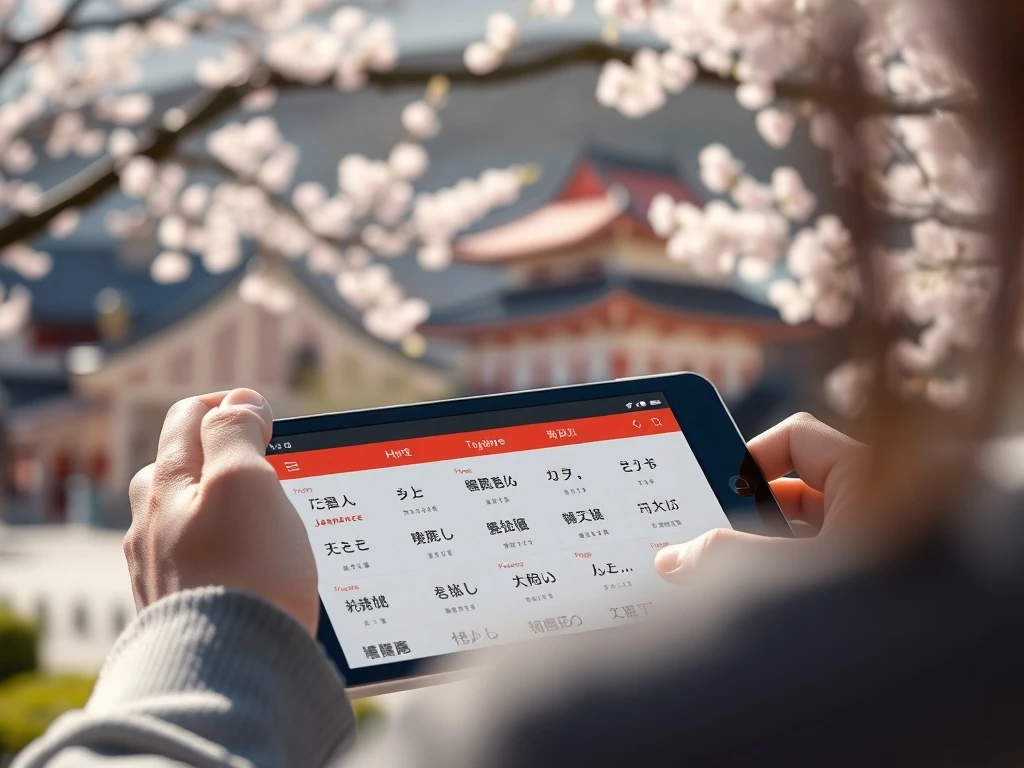In today’s interconnected global economy, acquiring new language skills offers a significant competitive edge. For business leaders and entrepreneurs, proficiency in Japanese can unlock vast opportunities in one of the world’s most innovative and culturally rich markets. Fortunately, the landscape of digital education has transformed, making it easier than ever to embark on this journey. This article explores the leading Japanese learning apps for 2025, providing a comprehensive guide to help you choose the best tools for achieving fluency and advancing your professional aspirations.
The Strategic Edge of Learning Japanese for Business
Learning Japanese extends far beyond cultural enrichment; it is a strategic investment for professionals. Japan remains a global economic powerhouse, boasting advanced technology, unique consumer markets, and a deeply ingrained business etiquette. Understanding the language allows for direct communication, fostering stronger relationships with partners, clients, and employees. This capability can lead to more successful negotiations, deeper market penetration, and a significant competitive advantage in various industries. Furthermore, navigating Japanese media and information sources directly provides invaluable insights for market analysis and trend identification. Truly, effective Japanese learning apps can accelerate this critical skill development.
Embracing Japanese language skills also demonstrates a profound respect for the culture, which is highly valued in Japanese business interactions. This respect builds trust and opens doors that might otherwise remain closed. Whether your goal is to expand operations, forge new partnerships, or simply understand the nuances of the Japanese market, language proficiency serves as a foundational pillar. Many individuals find that the right digital tools significantly streamline this complex learning process. Therefore, selecting the optimal Japanese learning apps becomes a pivotal first step.
Top Japanese Learning Apps for Comprehensive Fluency
The market for language learning technology continues to evolve, offering increasingly sophisticated solutions. For those serious about achieving true fluency, especially for professional contexts, certain applications stand out. These tools provide comprehensive approaches, moving beyond basic vocabulary to foster deep comprehension and practical application.
Migaku: The Immersion Game-Changer for Advanced Learners
For learners aiming for native-like Japanese proficiency, Migaku offers an unparalleled immersion system. It effectively transforms everyday media like Netflix shows, YouTube videos, anime, podcasts, and online articles into interactive study sessions. Users can instantly translate, save, and review new words directly within their authentic context. Migaku’s core strength lies in its integrated toolset. Automatic subtitle creation for videos lacking captions, dual-language displays, instant dictionary lookups, and spaced-repetition reviews ensure constant reinforcement in genuine situations. This method builds not only vocabulary but also deep comprehension and natural speaking ability. Over time, you don’t just ‘study’ Japanese—you truly live it. This app stands out among all Japanese learning apps for its unique approach.
- Integrated Immersion: Learn from real-world content.
- Contextual Learning: Understand words in natural sentences.
- Spaced Repetition: Efficiently reinforce new vocabulary.
- Customizable: Adapt to individual learning styles and content preferences.
Foundational Japanese Learning Apps for Beginners
Starting a new language can feel daunting. Fortunately, several Japanese learning apps excel at guiding beginners through the initial stages, providing structured lessons and clear explanations. These apps build a strong foundation, making the journey less intimidating and more motivating.
LingoDeer: Structured Pathways for New Learners
LingoDeer meticulously guides new learners step-by-step through Japanese grammar, listening comprehension, and kana/kanji practice. Its clear lesson flow makes starting the language less intimidating and more motivating. The app provides detailed explanations, engaging exercises, and regular quizzes to ensure understanding. LingoDeer’s design specifically caters to East Asian languages, offering accurate and culturally relevant content. Many beginners find its structured curriculum invaluable for building confidence and a solid linguistic base. It effectively bridges the gap between complex grammar rules and practical application, making it one of the most accessible Japanese learning apps for novices.
WaniKani: Mastering Kanji Systematically
Using a mnemonic and radical-based approach, WaniKani transforms the challenge of kanji acquisition into a logical, progressive system. Its 60 levels keep users moving forward without forgetting earlier material. WaniKani focuses on teaching kanji meanings and readings through memorable associations, followed by rigorous spaced-repetition reviews. This systematic method drastically reduces the time and effort required to master thousands of characters. For anyone serious about reading Japanese, WaniKani is an indispensable tool. It specifically addresses one of the most difficult aspects of the language, making it a highly specialized and effective choice among Japanese learning apps.
Specialized Japanese Learning Apps for Targeted Skills
As learners progress, they often identify specific areas requiring more focused attention, such as grammar, vocabulary expansion, or extensive reading. Several Japanese learning apps specialize in these particular skills, offering depth and precision that complements broader learning platforms.
Bunpro: Unlocking Japanese Grammar Mastery
Bunpro organizes Japanese grammar into digestible points, complete with multiple example sentences, interactive quizzes, and personalized review schedules. It proves especially useful for learners preparing for JLPT exams or those wanting to fill specific grammar gaps. Bunpro links directly to external resources like Tae Kim’s Guide to Japanese, making it a comprehensive grammar reference. Its systematic approach ensures users not only learn grammar rules but also understand their nuances and practical application. For focused grammar study, Bunpro stands out among other Japanese learning apps.
Anki: The Ultimate Flexible Flashcard Platform
Anki’s highly customizable spaced-repetition flashcards can be tailored to virtually any learning style or content. With the right community-created decks, it becomes a powerful companion for mastering vocabulary, kanji, or full example sentences. Anki’s flexibility allows users to create their own cards, incorporating images, audio, and detailed notes. Its intelligent algorithm optimizes review times, ensuring efficient retention of information. While it requires some initial setup, Anki’s power and adaptability make it an essential tool for dedicated learners. It provides a foundational memory tool that enhances all other Japanese learning apps.
LingQ: Immersive Reading and Listening for Advanced Progress
LingQ encourages massive input through an extensive library of books, podcasts, and videos. It meticulously tracks your known words as you progress into increasingly difficult material. This app is excellent for learners ready to dive into authentic Japanese content. LingQ’s system allows users to click on unfamiliar words to get instant translations and save them for review. This approach mirrors natural language acquisition, where exposure to large volumes of content leads to organic understanding. For those seeking to expand their passive vocabulary and comprehension, LingQ is an invaluable resource among Japanese learning apps.
Pimsleur: Building Conversational Confidence Through Audio
Pimsleur’s 30-minute audio lessons primarily focus on listening comprehension and pronunciation, making it ideal for those who want to practice Japanese hands-free during commutes or walks. The method emphasizes core vocabulary and phrases, encouraging users to respond verbally to prompts. This active recall strengthens speaking ability and builds confidence in practical conversations. Pimsleur avoids reading and writing initially, focusing solely on auditory and verbal skills. Its structured audio format offers a unique and effective way to develop conversational fluency, distinguishing it from many other Japanese learning apps.
Community-Driven and Conversational Japanese Learning Apps
Interaction with native speakers and a supportive community significantly accelerates language acquisition. These Japanese learning apps prioritize real-world communication and cultural exchange, providing invaluable opportunities for practical application.
Busuu: Interactive Lessons with Peer Support
Busuu combines quick, interactive lessons with a strong emphasis on peer feedback for writing and speaking exercises. Its manga-inspired Japanese course adds an engaging visual twist for beginners, making the initial stages more enjoyable. Users submit their practice exercises to a community of native speakers who provide corrections and encouragement. This direct interaction offers personalized feedback that traditional apps cannot replicate. Busuu’s comprehensive curriculum covers grammar, vocabulary, and cultural insights, all while fostering a supportive learning environment. It truly integrates community into the learning process, making it a standout among Japanese learning apps.
Memrise: Authentic Phrases from Native Speakers
Memrise uses short videos of native speakers to teach everyday expressions and practical vocabulary. It offers a fun, low-pressure way to build conversational vocabulary alongside other study methods. The app’s core strength lies in its focus on natural speech patterns and pronunciation, directly from native speakers. Memrise incorporates gamified elements to keep learners engaged and motivated. Its emphasis on real-world phrases helps users sound more natural and confident in conversations. For building practical, spoken Japanese, Memrise provides a highly effective and enjoyable experience among Japanese learning apps.
HelloTalk: Connecting with Native Japanese Speakers
HelloTalk connects you directly to native Japanese speakers for chat, voice messages, or calls, facilitating real-time language exchange. Built-in translation tools, correction features, and transliteration aids help you keep the conversation flowing as you improve. This app provides an authentic environment for practicing speaking and listening skills in a low-stakes setting. Users can find language partners based on interests, ensuring engaging conversations. HelloTalk is indispensable for moving beyond textbook learning and applying your skills in genuine interactions. It serves as a bridge to practical communication, making it a crucial addition to any list of Japanese learning apps.
Choosing the Right Japanese Learning Apps for Your Goals
Selecting the ideal Japanese learning apps depends entirely on your personal learning style, current proficiency level, and specific objectives. For instance, beginners might prioritize structured courses like LingoDeer, while advanced learners seeking fluency might gravitate towards immersion platforms like Migaku or conversation apps like HelloTalk. Consider whether you need strong grammar foundations, extensive kanji practice, or simply want to improve conversational flow.
Many successful Japanese learners combine several apps to create a holistic study plan. For example, you might use WaniKani for kanji, Bunpro for grammar, and Migaku for immersive content consumption. This multi-app approach allows you to leverage each tool’s unique strengths, covering all aspects of language acquisition. Always remember to integrate consistent practice and real-world application to maximize your progress. The best app is ultimately the one you use consistently and effectively.
Conclusion: Empowering Your Japanese Language Journey
The journey to Japanese fluency is a rewarding endeavor, offering significant personal and professional dividends. With the array of powerful Japanese learning apps available in 2025, achieving your language goals is more accessible than ever. From Migaku’s cutting-edge immersion system to the structured lessons of LingoDeer and the conversational opportunities of HelloTalk, technology provides robust support for every stage of your learning path. Embrace these innovative tools, commit to consistent practice, and unlock the vast potential that Japanese language proficiency offers in today’s globalized world.
Frequently Asked Questions (FAQs) About Japanese Learning Apps
Q1: What is the best app for learning Japanese from scratch?
For absolute beginners, LingoDeer is often recommended due to its highly structured lessons, clear grammar explanations, and systematic approach to kana and kanji. It provides a solid foundation for new learners.
Q2: Can I become fluent in Japanese just by using apps?
While apps provide excellent tools and resources, achieving true fluency typically requires a combination of app-based learning, consistent practice (speaking, listening, reading, writing), and often, interaction with native speakers. Apps like Migaku and HelloTalk facilitate immersive and conversational practice, significantly aiding fluency development.
Q3: How important is learning kanji for business Japanese?
Learning kanji is crucial for reading and understanding written Japanese, which is essential for business documents, emails, and news. Apps like WaniKani can systematically help you master kanji, a vital skill for professional communication in Japan.
Q4: Which app is best for practicing Japanese conversation?
HelloTalk is highly effective for practicing real conversations with native Japanese speakers. It connects you with language partners and provides built-in tools for translation and correction, making it ideal for improving your spoken Japanese.
Q5: Should I use multiple Japanese learning apps simultaneously?
Yes, many learners find success by combining different apps to target specific skills. For example, you might use one app for grammar, another for kanji, and a third for immersive content or conversation practice. This approach leverages the strengths of each app for a comprehensive learning experience.








